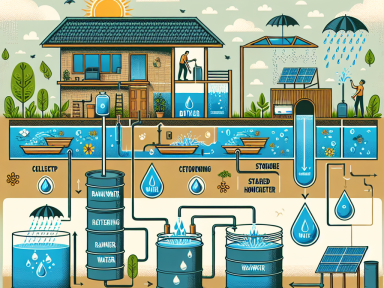Why Harvest Rainwater?
Water is life. Whether you’re an experienced homesteader or a beginner, this is a fact you already know. But what if there comes a day when your usual water sources are not readily available? This is a frightening scenario to ponder, but it’s better to be afraid and prepared than caught off guard. This is where rainwater harvesting comes in.
The principle of rainwater harvesting is simple: capture, divert, and store rainwater for future use. Imagine being able to supplement your primary water supply, save on your water bills, and have a sustainable, off-grid water source right at your doorstep. And the best part about rainwater? It’s free.
Getting Started on Harvesting Rainwater
1. Check Your Local Laws
Before setting up a rainwater collection system, it’s crucial to check your local laws about rainwater harvesting. Some areas fully encourage this practice, but others may have restrictions, especially in places where water resource is a significant issue.
2. Calculate Your Rainwater Yield
To estimate how much rainwater you can collect, you need to take into consideration your roof area and the average rainfall your area receives. The basic formula is inches of rainfall x square feet of roof area x 0.623. This will give you your rainwater collection in gallons.
3. Choose Your Collection System
From barrels to large tanks, the type of collection system you opt for is dependent on your needs and resources. Ensure that your system has a proper filtration system in place to remove debris and pollutants. It is also advisable to have an overflow system in place as a safety measure for heavy rainfalls.
Making Rainwater Safe for Use
Rainwater can be safely used for a variety of non-potable tasks such as toilet flushing, laundry, gardening, and even bathing. However, if you plan to use harvested rainwater as a drinking source, it is absolutely necessary to treat and purify it to safeguard against potential pathogens and contaminants. Popular methods to do this include boiling, chemical disinfection with bleach or iodine, solar disinfection, and filtering.
Boiling
Boiling is a simple, yet effective method of killing pathogens in water. However, it does not remove chemical pollutants.
Chemical Disinfection
Disinfection using household bleach or iodine is another common method. The dosage would depend on the clarity and temperature of the water.
Solar Disinfection
Solar disinfection (SODIS), an innovative method, involves exposing water-filled plastic or glass containers to the sun for a minimum of 6 hours.
Filtering
There are diverse water purifiers in the market, both portable and for household use, that can effectively purify rainwater.
Whether it’s a natural disaster, a municipal water shortage, or just wanting to live a more self-reliant lifestyle, having a rainwater harvesting system in place provides an immense sense of security. In these uncertain times, it’s more critical than ever to learn and implement self-reliance skills. Remember, preparedness is not about the fear of what might happen but the peace of mind in knowing that you’ve taken the necessary actions to protect and sustain your homestead.




GIPHY App Key not set. Please check settings